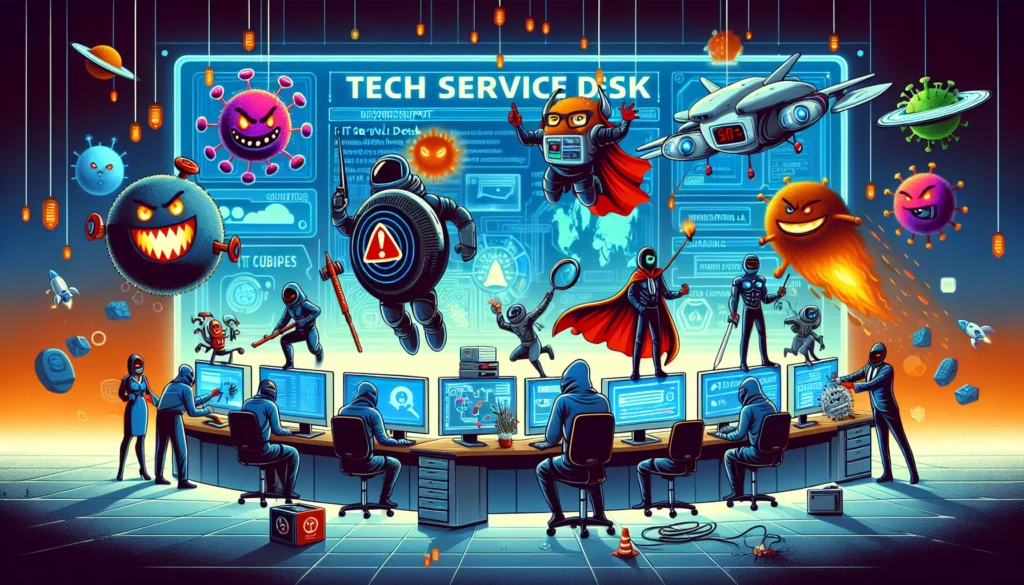Mitigating Threats to Service Desks: Strategic Solutions and Recommendations
Service desk agents play a critical role in assisting users during IT-related challenges, providing a personal touch that often enhances customer satisfaction. Unfortunately, this human factor also presents a vulnerability that cybercriminals are keen to exploit. By employing social engineering tactics, malicious actors may successfully manipulate service desk personnel into revealing sensitive information, resetting passwords, or facilitating unauthorized access.
Recent incidents have highlighted this issue, particularly with notable British retailers falling victim to the DragonForce ransomware. These attacks typically involve a cybercriminal organization, such as Scattered Spider, which gained initial access through service desk interactions.
Notable Incidents
1. Marks & Spencer (April–May 2025): Attackers successfully deceived the IT help desk into resetting passwords, compromising systems, and extracting personal data, which resulted in the suspension of online services for over three weeks.
2. Co-Op Group (May 2025): In a nearly identical scenario, the service desk staff were manipulated into granting system-level access. This breach led to the theft of customer contact details and staff credentials, impacting stock availability at over 2,300 locations.
3. Harrods (May 2025): This luxury retailer detected unauthorized access attempts linked to Scattered Spider before any data was compromised, emphasizing the ongoing threat to major brands.
4. Dior (May 2025): A data breach was confirmed, where unauthorized individuals accessed customer data without compromising financial details. The company is actively notifying affected parties and coordinating with cybersecurity professionals.
5. MGM Resorts (September 2023): Scattered Spider executed a vishing attack, manipulating staff into disabling two-factor authentication for a senior manager. This act initiated a ransomware assault that severely disrupted operations across their Las Vegas properties.
Why Service Desks Are Targeted
Cybercriminals target service desks because they represent a relatively easier avenue for breaching security compared to more sophisticated hacking methods. The main motivations for this choice include:
– Manipulation of Empathy: Attackers will pose as critical stakeholders, leveraging the service desk agents’ natural inclination to assist and resolve issues promptly.
– Exploitation of Trust: By invoking urgency or referencing organizational hierarchy, attackers can create situations where service desk personnel expedite processes that compromise security.
The Social Engineering Process
1. Reconnaissance: Attackers may conduct detailed research on their targets, using public information such as LinkedIn profiles and corporate announcements to craft believable pretexts.
2. Crafting Pretext: With specific knowledge of the organization, attackers develop scenarios that necessitate urgent assistance, such as being locked out of an account.
3. Initiating Contact: The attacker reaches out during busy periods to increase the likelihood of success. Some may utilize AI-generated voice technology to impersonate legitimate individuals from the organization.
4. Building Urgency and Trust: The attacker pressures the service desk agent by referencing high-profile individuals or urgent projects, prompting the agent to act quickly.
5. Bypassing Multi-Factor Authentication (MFA): If MFA is in place, attackers might claim they did not receive the authentication request, leading agents to reset MFA settings under false pretenses.
6. Credential Manipulation: The service desk agent may then disable existing authentication and provide new credentials—unwittingly granting the attacker access to the organization’s systems.
Strengthening Service Desk Security
To enhance security, organizations must implement comprehensive training and simulation programs, aiding teams in recognizing and responding to social engineering attempts. Additional measures should include enforcing the principle of least privilege and enhancing verification processes.
Integrating rigorous identity verification protocols into service desk operations is essential. By mandating verification, organizations can introduce a crucial layer of defense that deters even the most convincing social engineering attempts.
Implementing solutions that combine multi-factor verification, real-time risk assessment, and customizable challenge processes is vital for safeguarding against illicit access attempts. These robust measures significantly reduce the potential for human error in security protocols and empower service desk teams to perform their duties securely.
In conclusion, addressing the vulnerabilities at the service desk is imperative for organizations wishing to fortify their security posture against increasingly sophisticated cyber threats.








